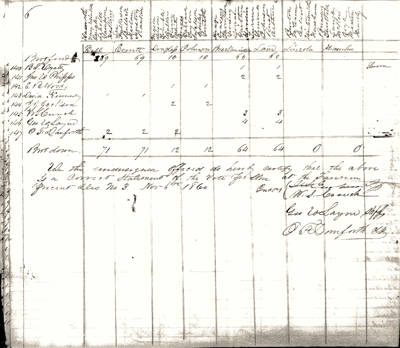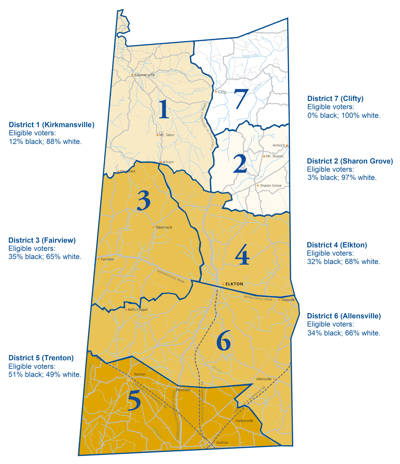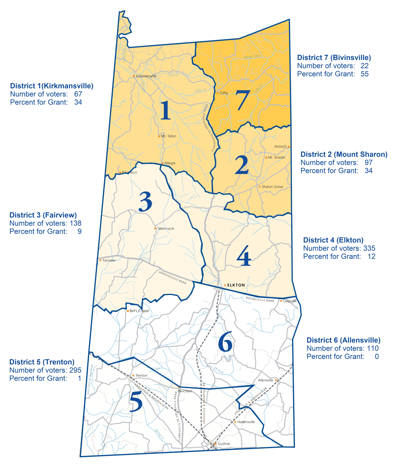


Final page of the Fairview pollbook for the November 1860 presidential election showing the votes of the final few voters of the day (including E. G. Wood, the man who abducted Mattie Link’s children) and the tallies for each candidate. Note that Lincoln and Hamlin electors did not receive any votes in Fairview precinct.

Louisville Courier Journal, a Democratic Party newspaper, made calculations about which Kentucky counties the “Radicals” (Republican Party) might be able to win with the enfranchisement of African American men. Todd County is one of the counties (along with Garrard County) included in their list.
Louisville Courier Journal April 14, 1870.

The opportunity for the Republican Party: Newly enfranchised African American men made up a sizeable proportion of the eligible electorate in 1870 in the south of the county, including around the county seat, Elkton.
The GOP Fails in Todd: Part 1
Opportunities for the Republican Party After the 15th Amendment Came into Force
This is the first part of a two-part story about the failure of the Republican Party to get a foothold in Todd County, Kentucky in the 19th century. The second part can be accessed here.
At the time of the 15th Amendment in March 1870, Todd County was one of those southern places that looked to be a likely Republican gain because it had a large black population. According to the U.S. Census, there were 4,852 African Americans in Todd County in 1870, making up 39% of the county’s population. This was twice the average in Kentucky (17%) and the seventh highest in any Kentucky county.
If a cross-racial alliance—between white Republicans in the north of the county and black Republicans in the south—could be formed, the Republican Party could have been an electoral force to be reckoned with in Todd County.
In reality, however, the Republican Party was not competitive in Todd County until the 1980s (by which time it was a very different party). A combination of factors—the geographic separation of white Republicans (in the north) and black Republicans in the south of the county, a lack of leadership from the lawyer class in Elkton, and the loyalty of the only formal party leader to the state and national party—ensured that a cross-racial alliance never emerged and the Republican Party languished as a minority party for a century.
In Part 1 of this story, we explore the opportunity the 15th Amendment presented for the Republican Party and the geographical challenges a Republican machine faced in forming an effective cross-racial alliance.
The Opportunity
A Whiggish Past
Before the demise of the party in the 1850s, Todd County had been an important center of Whig politics. In 1852, 61% of voters in the county chose the Whig presidential candidate. The county produced prominent Whigs like Elkton lawyer, Francis Marion Bristow, Representative for the Kentucky 3rd District (Whig, 1854-55), and Allensville lawyer, Jacob Shall Golladay (Whig in the Kentucky State Legislature, 1851-55).
Throughout the 1860s, the county’s (white) voters urged moderation in presidential elections. In 1860, 74% of votes went for candidates from moderate parties (the Constitutional Union Party and the northern Democratic Party, both opposed to succession), while the secessionist Southern Democratic candidate won only 26% of the vote.
Underperforming Republicans
However, the Republican Party had performed poorly in Todd County since it first appeared on ballots there in 1860. Abraham Lincoln secured a total of only eight (8!) votes across the whole county in the 1860 presidential election. Throughout the 1860s, the Party generally turned out few more than 100 voters. In 1864, Lincoln received 105 votes (21%). In the 1868 presidential election, Ulysses S. Grant won only 128 votes (12%). In that same election, the Republican congressional candidate received only 109 votes. The Republican Party must have been enthused when, in the 1867 gubernatorial election, the Republican candidate won 160 votes (19%) in the county).
The Partisan Math
Based on recent electoral history, a political strategist running the numbers in 1870 could count a predictable Democratic vote of between 700 and 950 in Todd County. Against that was the 100 to 160 white votes for the Republican cause. Republicans would need to hold the whole of the white vote and turn out between 600 and 850 black voters to win the county.
Such a turnout if black men did not look impossible. According to the 1870 Todd County tax list, there were 930 black men in Todd County aged 21 and older. The 1870 Census counted 959. So, for the Republican Party, everything hinged on being able to turnout newly enfranchised black men.
Democrats Worry that Todd County will Fall to the Republican Party
Based on the numbers of black men, Democrats speculated that the Republican Party might indeed be competitive in Todd County. The Louisville Commercial Journal, a Democratic Party paper, did its own numbers, adding its best estimate of the number of newly enfranchised black men in Todd County (879) to the 1868 white vote for Grant (128), to get a total of potential Republican vote of 1,007: Just above Democrat Horatio Seymour’s tally in the 1868 presidential election (947).
As the editor no doubt realized, these numbers assumed well over 90% turnout of newly enfranchised African American men, with each and every one voting Republican. An unlikely scenario, to say the least.
Still, Democrats feared potentially losing Todd County to the Republican cause.
The Challenge
In 1870, the Republican Party was not well established in Todd County. Having been formed only in 1854 in Michigan and Wisconsin in opposition to slavery, its base was in the Midwest and Northeast.
In Todd County, support for the Republican Party was limited to the sparsely populated northern part of the county.
In order to be competitive, Republican organizers would need a working cross-racial alliance like the sort that was created in Garrard County, one which maximized turnout among white Republicans in the north of the county while bringing newly enfranchised black men to the polls en masse from the south of the county.
A County Divided
Todd County was divided between a north largely unconnected to slavery, with a population 95% white, and a south entirely defined by it, with almost as many black people as white. In the rolling hills of north county, farmers tilled corn and tobacco on small farms without the use of enslaved black labor. By contrast, the tobacco plantations beginning in Elkton and stretching through the southern reaches of the county to the Tennessee line were large and dependent on enslaved black labor. The tobacco plantations of the south of the county were indistinguishable in many ways from the cotton plantations of the Deep South.
In the northern part of the county, the Republican Party had been competitive before 1870, with Grant winning the Bivinsville precinct (Magistrates District 7; 55%), and sizable minorities in Browning’s Tanyard (in Magistrates District 3, north of Tabernacle; 44%), Kirkmansville (Magistrates District 1; 34%), and Mount Sharon (Magistrates District 2; 34%) in the 1868 presidential election. However, only one fifth of voters (215 in total) came from these northern precincts.
In the five populous precincts in the south of Todd, Grant won only 5% of the 1868 vote. In neither the Allensville precinct (Magistrates District 6), five miles from the Tennessee line, nor the Hadensville precinct (in Magistrates District 5), two miles north of the border, was a single vote cast for Grant. Every single one of the 218 white men who voted in those two precincts declared his preference for Democratic former governor of New York, Seymour.
In order to win the county in 1870 and beyond, Republican leaders needed to maintain and grow their support in the north while turning out black men in the south. This would have been a tall order for even a well-organized party machine with active organizers in both the north and southern reaches of the county, but the small, localized, and disorganized Todd County Republican movement was far from up to the challenge.
In the second part of this story, we explore the many ways in which the Republican movement in Todd County was not up to the challenge of forming a cross-racial alliance, including an absent lawyer class and the state and national loyalties of the formal party leader. We also explore how a promising Republican newspaper editor who stood up to the tyranny of the KKK failed to become a party leader and highlight the challenges for potential black party organizers using the cases of two well-connected and politically actively black men in the county.








